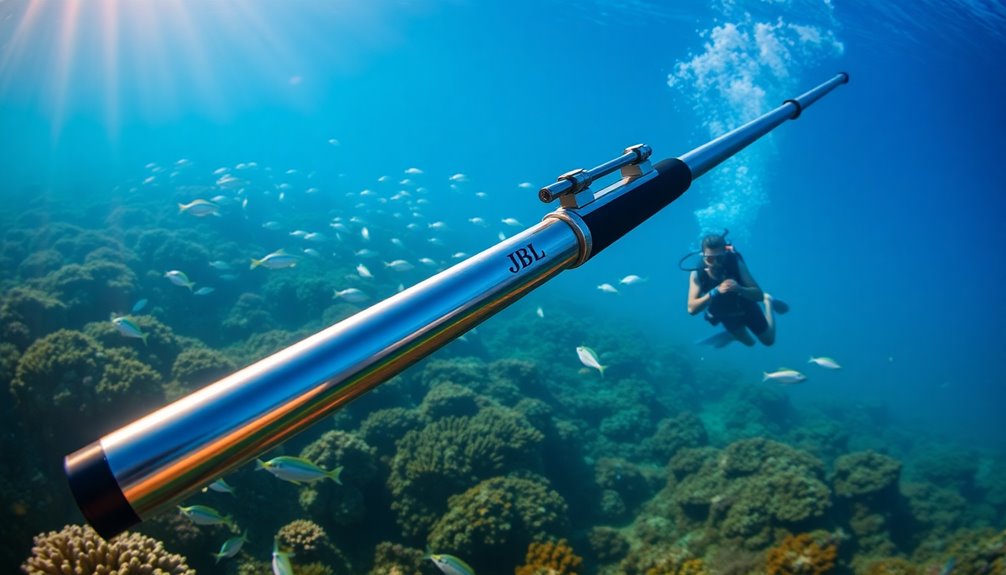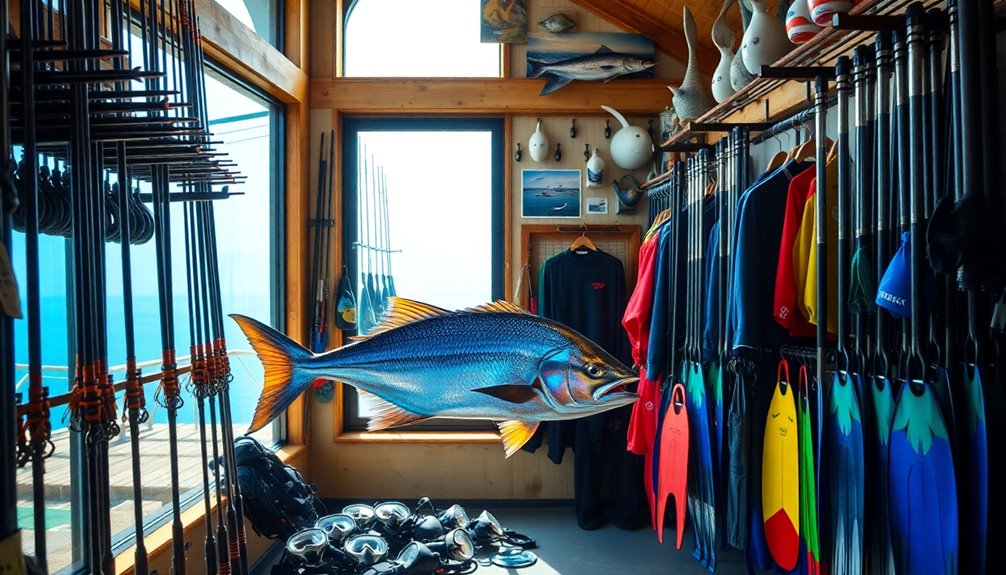A dive float is your surface beacon for safety and success while exploring underwater! It helps keep you visible to boaters, making diving safer and more enjoyable. When displayed, dive floats alert others that divers are present, so they can steer clear. Always keep your float at the highest point so it can be seen from all directions. Don't forget, there are different types of flags to choose from, each with its role. Your float not only shows your location but also adds to the excitement of your underwater adventure. Keep going, and you'll discover even more diving tips!
Key Takeaways
- A dive float serves as a surface marker, enhancing visibility for boaters and ensuring diver safety during underwater activities.
- It is crucial to attach a dive flag to your float, adhering to legal requirements and alerting nearby vessels of your presence.
- Use a brightly colored float to improve visibility, especially in low light conditions or during night dives.
- The float can also hold a surface marker buoy (SMB) to help with navigation and locating fellow divers.
- Always ensure your dive float is securely tethered and easily deployable for quick access during emergencies.
Importance of Dive Flags
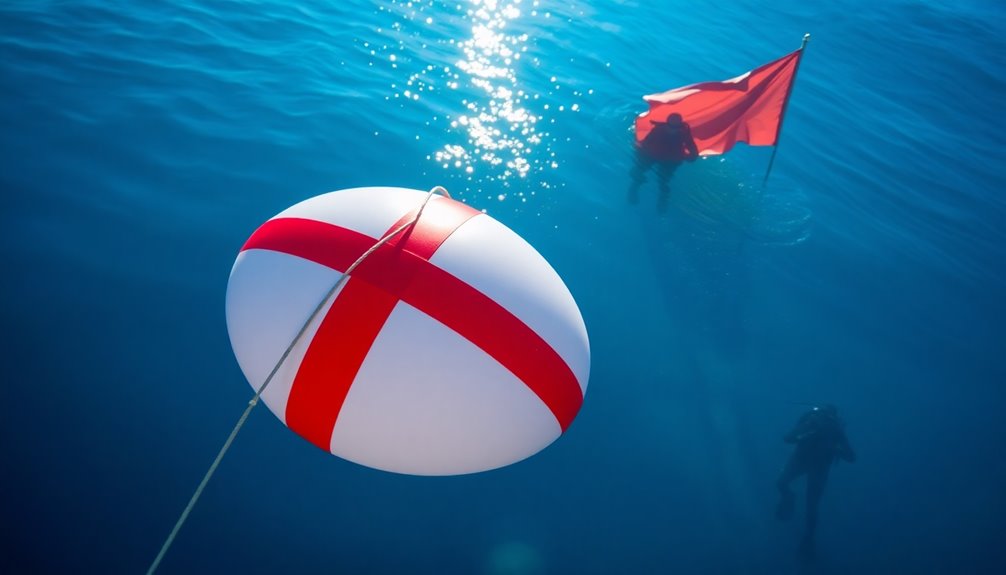
When you hit the water for a dive, displaying a dive flag is crucial for your safety and the safety of others. This bright flag alerts boaters and personal watercraft operators that there are divers in the water. You want to make sure it's clearly visible, so mount it high enough—at least two feet above the surface of the water. Bright colors help the flag stand out, making it easier to see from a distance.
Following safety regulations is also essential. Federal and state laws require dive flags during diving activities to prevent accidents. Boaters need to stay at least 300 feet away from the flag in open water, giving you a safe space to explore. Additionally, boater responsibility requires them to maintain a safe distance to ensure diver safety.
As a diver, you should stay within 150 feet of the flag and surface nearby. Remember, displaying a dive flag when you're not diving is against the law.
Using a dive flag not only keeps you safe, but it also helps prevent confusion. It signals to boats that they should slow down and maintain a safe distance.
Types of Dive Flags
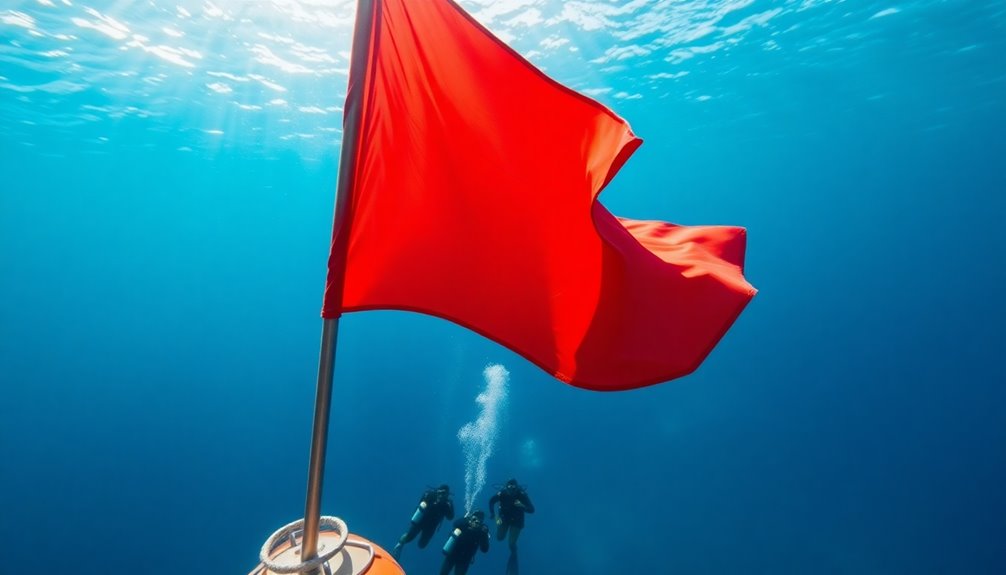
Displaying a dive flag is just the beginning of ensuring safety while underwater.
You've got two main types of dive flags to know about: the Diver Down Flag and the Alpha Flag. The Diver Down Flag is a bright red rectangle with a white diagonal stripe. It shows that scuba divers or snorkelers are in the area. Many places, especially in the US and Canada, require you to display this flag from your boat or buoy when diving. Remember, boats must stay at least 300 feet away in open water! Additionally, it's important to note that the distance requirements for boaters to stay away from divers can vary by state.
On the other hand, the Alpha Flag is blue and white, shaped like a pennant. This flag tells everyone that a vessel is engaged in diving operations and has limited movement. It's recognized around the world.
Both flags help keep divers safe by alerting boaters to stay back and be cautious.
You should place your flags where they're visible from all angles, like the highest point of your boat. Combining both flags during your dive can give you extra safety.
Now, you're ready to explore the underwater world with confidence!
Night Diving Visibility

As the sun sets and darkness envelops the underwater world, ensuring visibility during night dives becomes crucial for both safety and enjoyment.
You'll want a strong primary dive light to illuminate your path and help you spot amazing marine life. Bright LED lights are a great choice because they last a long time and shine brightly. Don't forget a backup light, too, just in case your main one fails.
At night, everything can look different. Rapid movements might make you feel dizzy or confused, like driving in a snowstorm. To stay steady, remember to descend slowly and keep your feet first. Using a descent line helps you stay on track. Additionally, be aware that nocturnal species become more active after sunset, enhancing the excitement of your dive.
For navigation, surface marker buoys (SMBs) are your best friend. They let boats and other divers know where you are, which is super important in the dark. If you get separated from your buddy, shine your light outward while turning in a circle to find them.
With the right lighting and tools, you'll have a fantastic time exploring the night dive.
Stay safe, and enjoy the magical underwater world!
Diver Freedom Configuration
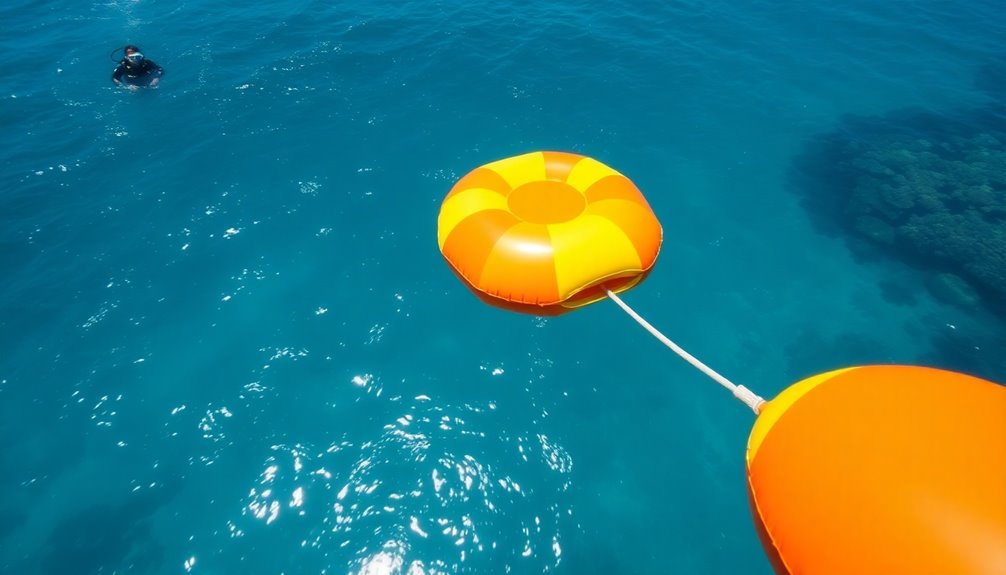
Before you dive into your underwater adventure, setting up your Divesoft Freedom computer is essential for a smooth experience. First, activate the surface mode main menu with a quick press of both keys. You'll see a variety of options—select Setup to adjust your preferences.
If you want to change the display orientation or switch to imperial units, you can do that easily in the Preferences section.
Once you're ready to dive, select Dive → Default (OC) for open circuit SCUBA diving. Don't forget to verify and confirm your settings before you enter the water. It's important to have the computer switched on for your predive checks. Additionally, having a dive flag displayed ensures safety by signaling your presence to nearby boats.
Review your decompression settings on the first screen, and if you're using a rebreather, check the specific parameters on the second screen.
When it comes to hardware, the Divesoft Freedom has a consistent design across all versions. Attach the strap securely and charge your device using the included USB charger.
Legal Requirements and Compliance

Understanding the legal requirements for diving is just as important as ensuring your Divesoft Freedom computer is ready for your adventure.
When you dive, you need to display a divers-down warning device. This flag must be at least 12 inches by 12 inches and easily seen from the water. If you're on a boat, make sure it's up high so everyone can spot it.
You also have to stay close to your flag. In rivers and channels, stay within 100 feet, and in other places, keep it to 300 feet. Boats should stay back too, at least 100 feet in channels and 300 feet elsewhere. Remember, divers must remain within 50 feet of the flag in federal waters.
Your flag needs to be square or rectangular, with a divers-down symbol and white stripes. Remember, it's against the rules to display this flag if you're not diving. You should stick to within 50 feet of your flag and surface close by unless there's an emergency.
If you don't follow these rules, you might face fines or other penalties.
Frequently Asked Questions
How Do I Properly Maintain My Dive Float?
To properly maintain your dive float, rinse it with fresh water right after use, especially if you've been in saltwater or chlorinated pools.
Check for any leaks by inflating it and looking for bubbles. Make sure moving parts, like inflation buttons, work smoothly.
Clean any dirt or debris, and don't forget to let it dry completely before storing.
Regular checks ensure it stays in great shape for your next adventure!
Can I Use Homemade Dive Flags?
Yes, you can use homemade dive flags, but they need to follow certain rules in North Carolina.
Your flag must be square, at least 12 inches on each side, with a red background and a diagonal white stripe.
Make sure it stays visible and doesn't block navigation.
It's super important to keep safety in mind while diving, so always check local laws before using your homemade flag!
Happy diving!
What Should I Do if My Dive Flag Gets Damaged?
If your dive flag gets damaged, don't worry!
First, check for tears or frayed edges. If it's too worn, it's time to replace it. Make sure to choose a flag that meets local rules and is the right size.
When you get a new one, pick a durable material to withstand the elements.
Always store your flag in a dry place, away from sunlight, to keep it in great shape for your next adventure!
How Can I Ensure My Dive Float Is Visible During the Day?
To make your dive float super visible during the day, use bright colors like yellow or green!
Adding reflective materials can really help, too. Make sure your float is big enough to see but not too big to handle easily.
Attach a flag that stands out, like a blue and white dove-tailed alpha flag.
Are There Specific Colors for Dive Floats in Different Regions?
Yes, there are specific colors for dive floats that can vary by region!
Red is the most popular color because it's super visible and well-known. Many places use a red flag with a white stripe, but some areas might've different rules.
Always check local guidelines to make sure you're using the right colors and sizes. Staying visible helps keep you and other divers safe while you explore underwater!
Conclusion
So, whether you’re diving during the day or exploring the night, remember to use your dive flags! They help keep you safe and make your adventures even more fun. Plus, knowing the rules and staying visible means you can dive freely and confidently. Dive in, enjoy the underwater world, and always prioritize safety! With the right preparation, your diving experiences will be exciting and successful. Happy diving, and don’t forget to share your adventures with friends! As you embark on your underwater journeys, consider exploring free diving techniques for beginners to enhance your skills and enjoy the experience even more. Practicing breath control and relaxation will not only extend your dive times but also deepen your connection with the marine environment. Remember to always dive with a buddy and communicate your plans to ensure a safe and enjoyable adventure together.


